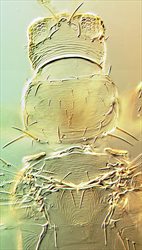
Head & thorax

Head

Antenna
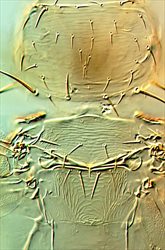
Pro, meso & metanota
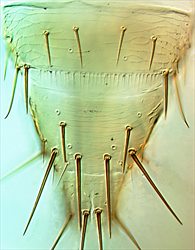
Tergites VIII-X
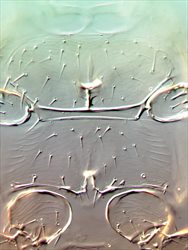
Meso & metathoracic furcae
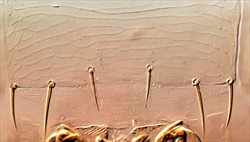
Female sternite VII
Both sexes fully winged. Body, legs and antennae light brown, tarsi and tibial apices yellowish brown, antennal segment III and base of IV yellow; fore wings shaded. Antennae 8-segmented; segment I with paired dorso-apical setae; segments III–IV each with apex slightly narrowed, sense cone forked; V broad at apex and VI broad at base, VIII longer than VII. Head slightly wider than long; eyes with a few weakly pigmented facets; 3 pairs of ocellar setae, pair III long, arising within ocellar triangle but close to anterior margins. Pronotum with 2 pairs of long posteroangular setae, two pairs of posteromarginal setae, about 20 discal setae. Mesonotum with paired campaniform sensilla anteromedially; median pair of setae far anterior to posterior margin. Metanotum transversely reticulate medially; median setal pair near anterior margin, no campaniform sensilla. Mesothoracic spinula weak or even absent, metathoracic spinula well-developed. Fore wing with 2 setae on distal half, near apex, second vein with about 10 setae. Abdominal tergites without ctenidia or craspeda; II–VII with no sculpture lines medially, lateral sculpture lines sometimes bearing microtrichia, a fringe of microtrichia on posterior margin laterally; tergites VI–VIII with median setal pair more than 0.5 as long as median length of tergite, VIII with complete comb of long, fine microtrichia; IX with 2 pairs of campaniform sensilla, X with median split about 0.5 length of tergite. Sternites without discal setae, setae S1 on VII arising in front of margin.
Male similar to female but smaller; antennae 8-segmented, similar in form to female; sternites withoout discal setae or pore plates.
The genus Mycterothrips, with 27 species worldwide, is primarily but not exclusively Holarctic (Masumoto & Okajima, 2006). Five species are known from Europe, with two more in the wider Mediterranean area (zur Strassen, 2003). The species latus is unusual within the genus in that the mesosternal spinula is weakly developed.
Feeding and breeding on leaves, particularly on Betula [Betulaceae], but probably pupating at ground level.
Described from a female taken in Northumberland in 1911 (Bagnall, 1912), and subsequently taken infrequently but widely in England and Scotland north to Inverness (Mound et al., 1976). This thrips appears to have a Euro-Siberian distribution and has been reported as far south as Iran.
THRIPIDAE - THRIPINAE
Mycterothrips latus (Bagnall)
Physothrips latus Bagnall, 1912: 191
Physothrips propinquus Bagnall, 1921: 62
Taeniothrips propinquus f. foliorum Priesner, 1964: 76
Bagnall RS (1912) A further contribution towards a knowledge of the British Thysanoptera (Terebrantia). The Journal of Economic Biology 7: 189–194.
Masumoto M & Okajima S (2006) A revision of and key to the world species of Mycterothrips Trybom (Thysanoptera, Thripidae) Zootaxa 1261: 1–90.
Mound LA, Morison GD, Pitkin BR & Palmer JM (1976) Thysanoptera. Handbooks for the Identification of British Insects 1 (11): 1–79.
zur Strassen R (2003) Die terebranten Thysanopteren Europas und des Mittelmeer-Gebietes. Die Tierwelt Deutschlands 74: 1–271.